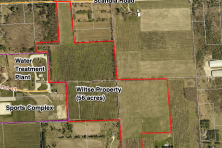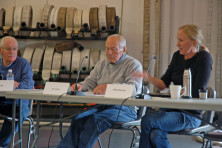Sturgeon bay Hotel Plan Bashed at Hearing
- Share
- Tweet
- Pin
- Share
At a 2½-hour standing-room-only public hearing before the Sturgeon Bay Plan Commission on Nov. 19, a steady stream of opponents of the proposed five-story hotel on the city’s western waterfront told the commission why they did not like the plan.
The reasons for opposition ranged from the politically naïve belief that the project was developed behind closed doors, to those who want the city to keep the entire three-plus acres of city-owned waterfront property as public land, to those who said they are not against development but expressed aesthetic disgust with the big box look of developer Bob Papke’s plan for the five-story Lindgren Hotel, named for his grandparents, who owned a hotel at Louisiana and Third in mid-20th century downtown Sturgeon Bay.
Papke opened the hearing by talking about his own roots in the city, being at his grandparents’ hotel and growing up in downtown Sturgeon Bay as a bike- and skateboard-riding kid, and then explaining his proposal for a 19,000-square-foot, 90-room boutique hotel at the foot of the northwestern side of the Oregon-Maple Street Bridge as part of the city’s overall West Waterfront Redevelopment Plan.
Papke said that it was the city’s idea – not his – to include commercial properties in its waterfront plan as a way to pay for the public portions “without keeping taxpayers on the hook,” and that the original concept of a hotel with 36 to 39 two-bedroom kitchenettes was changed after market research into the present 90-room, no kitchens or bathtubs concept, which, he added, is the fourth revision of the hotel plan.
“Earlier ones were a little more scary, a little more institutionalized,” Papke said.
Acknowledging that he was already aware that the look of the building was what drew most of the people to the hearing, Papke said, “Everyone has their own ideas of what makes the best building.”
Adding that he welcomes ideas, but with the knowledge that not all ideas can be incorporated, Papke closed by saying his investment in the hotel is a way of acknowledging that Sturgeon Bay has finally come into its own as part of the Door County experience, as opposed to the days when folks would stop in the city to ask how much farther to Door County.
“Sturgeon Bay has really come online, and it’s pretty cool,” he said.
“I am here because I saw the photo in the newspaper, and I said ‘Oh my god, this looks like a two-star hotel at O’Hare Airport.’ That’s why I came tonight,” said Sturgeon Bay resident Hans Christian, who was the first of 44 people to speak against the hotel at the public hearing, and whose words were echoed by many others, such as architect Virge Temme, who said the hotel as presented is out of scale with the rest of Sturgeon Bay.
“At five stories in height, this proposed hotel with its massive unbroken façade has the architectural scale and character of a big city hospital or a commercial office building,” she said.
Sturgeon Bay resident Shawn Fairchild suggested the slate should be wiped clean and the whole concept rethought, with inclusion of the old granary.
He said it was all too reminiscent of the process before Stone Harbor was built.
“We were told there were going to be visual corridors to the water, and when it ended up, it was a solid line all the way down,” he said.
“We’ve created a canyon of our canal going down from Sturgeon Bay to Lake Michigan, and this would close the last window on that canyon. We need to have that public visual corridor available for anyone. It’s valuable. So I suggest we do something different, out of the box.”
One of the four people to speak in favor of the project was Sturgeon Bay resident and Door County Economic Development Corporation Executive Director Bill Chaudoir, who said the city should be commended for stepping forward to buy the property and making sure there was proper development.
“This was an eyesore,” he said. “They’ve already made significant improvements by demolishing a lot of buildings that were dangerous and an eyesore. I think the city has the same objective as everyone here – and that is to make a beautiful, one-of-a-kind waterfront that people will flock to this community to enjoy.”
Most communities with similar opportunities use the state’s tax incremental financing district as the tool to pay for public projects, Chaudoir said.
“The public improvements that are envisioned in this project are going to be fantastic, but how do you pay for it?” he asked. “Most communities rely on TIFs to pay for them. That’s what this is all about. That’s the difference of opinion here tonight. Some people aren’t considering how it’s going to be paid for.”
Chaudoir also addressed those who believe the city’s waterfront redevelopment plan has been done in secret.
“Our city council created a TIF district on this property with the objective of, you want these public improvements, well, we have to have some development to pay for it. That’s the plan. It’s not been kept in secret. It’s been public. We worked very hard since that plan came out three years ago to find developers that are going to do the kind of friendly development we want to complement our waterfront.”
So what’s next?
“The fact of the matter remains, the Plan Commission needs to make a recommendation,” said city Community Development Director Marty Olejniczak after the hearing. “There is a time limit in the ordinance, 60 days to make their recommendation. As far as I know, unless the developer, Mr. Papke, would say, I’m pulling back, they would continue to go forward, deliberate and come up with whatever recommendation here is appropriate.”
While there have been scores of public meetings on the subject of the redevelopment plan, Olejniczak said there was obviously a lot of misconception and misunderstanding about the plan and the process.
“I don’t think they understood that we are trying to create some public open space down there. Having some private tax dollars is going to help support that,” he said. “They feel this view has been there since God created it, but actually it’s only been there since last fall when we took down the dilapidated buildings.
“It’s kind of a balancing act to have a fair amount of public access, public space, to attract people down to the waterfront but at the same time have the tax base to help support it. There’s a lot to consider here,” Olejniczak continued. “I’m certain that people are going to take a lot of those criticisms of the hotel to heart. I think it definitely could be improved. I haven’t heard anyone say it was perfect as it was. I think even people who support development want to see it changed.
“I would stress, look at the overall redevelopment plan and consider what we started with and what we’re trying to achieve. Try to separate that from the hotel itself. They really are two different matters. One is doing a redevelopment project and the other is the five-story hotel. You can like one without liking the other. Hopefully, Mr. Papke will listen to some of the comments and make some adjustments to it and give the planning commission the very best design they can.”
You can watch the entire public hearing on the city’s website, sturgeonbaywi.org. Although the next meeting of the Sturgeon Bay Plan Commission was scheduled for Dec. 17, a special meeting has been called for 7 pm on Dec. 3 to consider the hotel.



